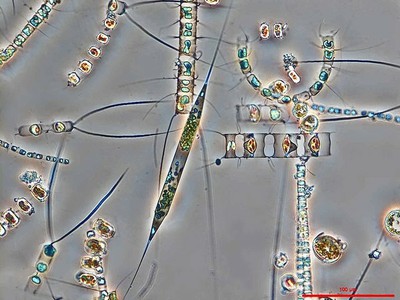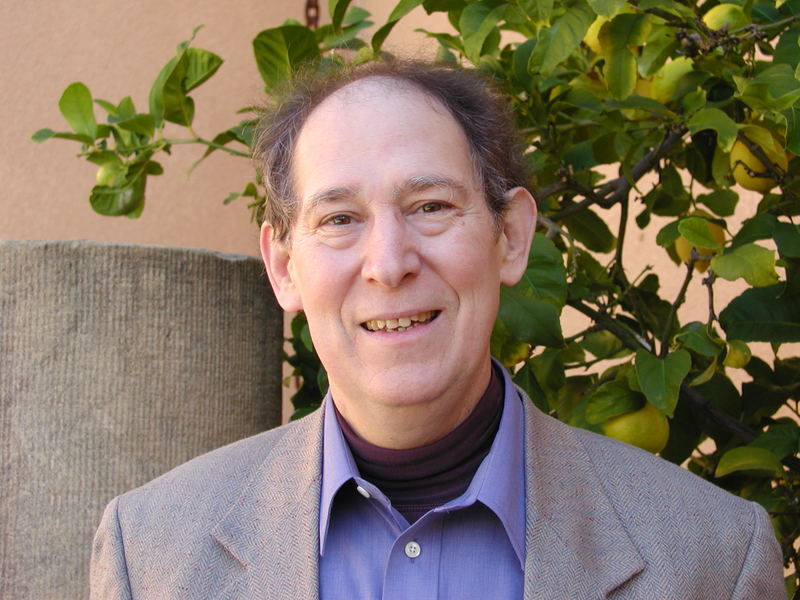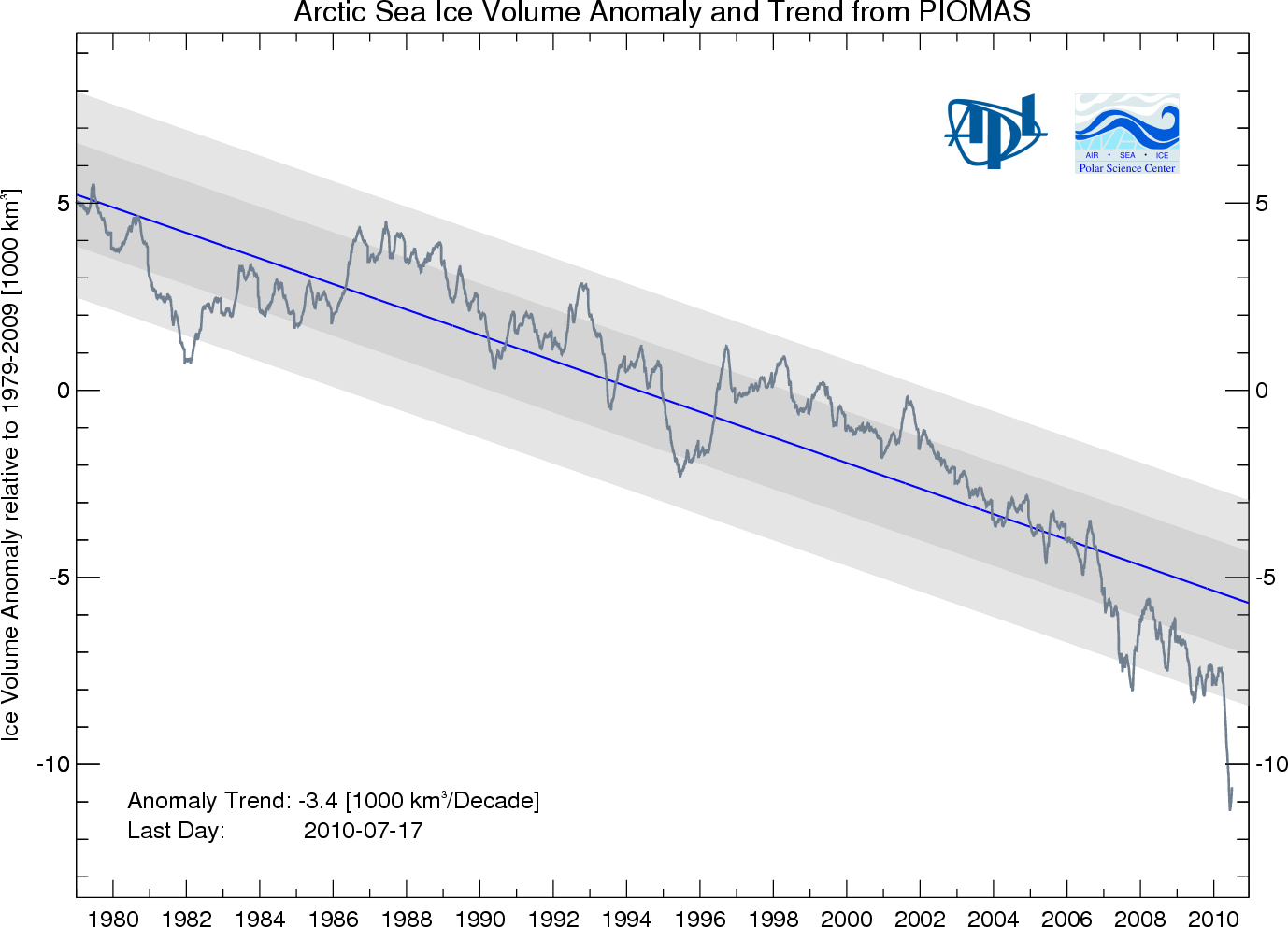July 19: Dr. Stephen Schneider passed away unexpectedly in London • July 17: The Polar Science Center observes anomalous drop in Arctic ice volume • July 16: The National Academy of Sciences released a summary report on climate stabilization targets pertaining to emissions, concentrations, and impacts over decades to millennia. July 28: NOAA/BAMS releases 2009 State of the Climate Report
Professor Stephen Schneider
July 29: Global Phytoplankton Levels in Retreat
A new study published in Nature indicates that global levels of phytoplankton have been dropping strongly since about 1950. The study indicates that global phytoplankton levels may be down 40% since the 1950s. This study brings yet another potential signal into the spotlight that may prove significant to the global warming assessments. Future studies will refine the understanding of this study and likely provide more robust modeling and consideration of global phytoplankton levels.
From the Study:
“These fluctuations are strongly correlated with basin-scale climate indices, whereas long-term declining trends are related to increasing sea surface temperatures.”

The study concludes significant correlation to global warming ocean temperatures continue to increase, and that further studies “this decline will need to be considered in future studies of marine ecosystems, geochemical cycling, ocean circulation and fisheries.”
- Source: https://www.nature.com/nature/journal/v466/n7306/edsumm/e100729-03.html
- Source: https://www.nature.com/nature/journal/v466/n7306/abs/nature09268.html
- Source: https://www.nature.com/nature/journal/v466/n7306/full/466569a.html
July 28: NOAA/BAMS releases 2009 State of the Climate Report (sotc)
Source: https://www.ncdc.noaa.gov/bams-state-of-the-climate/
A comprehensive review of key climate indicators confirms the world is warming and the past decade was the warmest on record. More than 300 scientists from 48 countries analyzed data on 37 climate indicators, including sea ice, glaciers and air temperatures. A more detailed review of 10 of these indicators, selected because they are clearly and directly related to surface temperatures, all tell the same story: global warming is undeniable.
Source: https://www.metoffice.gov.uk/corporate/pressoffice/2010/pr20100728.html
Source: https://www.metoffice.gov.uk/corporate/pressoffice/2010/pr20100728.html
July 19, 2010: Professor Stephen Schneider
Climate scientist at Stanford University – passed away on July 19. Steve was a dedicated author contributing to all four IPCC assessment reports. He also worked tirelessly to disseminate knowledge about man-made climate change. The scientific community will deeply miss this great leader.
In the following video we can see Professor Schneider delivering clearly the risks involved based on the scientific consensus, in 1979.
On July 8th, 2010, Steve Schneider did an interview regarding the integrity of climate science. He clearly illustrated the work he and colleagues had done on the integrity difference between denialists and working climate scientists by the body of peer reviewed work they had done. The results clearly showed that those arguing that global warming is not human caused did not have any relevant amount of credibility on their side.
In this interview, we can see that the debate is not between some scientists and other scientists, but rather between those that look at all the evidence and those that really only look at the pieces of the evidence that fit their perspective or agenda. The now ‘well established’ science shows not only that current global warming is human caused, but that significant impacts are expected in all areas of societal function and resource capacity of earth in relation to human society. Rapid action is still needed and rapid action is still being delayed by those that continue to muddy the waters of science with out of context perspectives, general opinions and incorrect science.
Possibly the last interview conducted with Professor Schneider:
Source: YouTube & Article from Climate Science Watch
It remains for all to hold the standards high and carry on, to bring the message of well established science to the world in order to enable meaningful action of the critical issue of climate change due to human-caused global warming.
Arctic Ice Volume
July 17 – Polar Science Center
An anomalous drop has been noted in the PIOMAS ice volume model that is outside the previous trend range. Future measurements will confirm the extent of the anomaly.
Near-Term Emissions Choices Could Lock In Climate Changes For Centuries to Millennia
Climate Stabilization Targets
July 16, 2010 — Choices made now about carbon dioxide emissions reductions will affect climate change impacts experienced not just over the next few decades but also in coming centuries and millennia, says a new report from the National Research Council. Because CO2 in the atmosphere is long lived, it can effectively lock the Earth and future generations into a range of impacts, some of which could become very severe.
From The National Academies Press
Emissions, Concentrations, and Impacts over Decades to Millennia
“Emissions of carbon dioxide from the burning of fossil fuels have ushered in a new epoch where human activities will largely determine the evolution of Earth’s climate. Because carbon dioxide in the atmosphere is long lived, it can effectively lock the Earth and future generations into a range of impacts, some of which could become very severe. Therefore, emission reduction choices made today matter in determining impacts experienced not just over the next few decades, but in the coming centuries and millennia. Policy choices can be informed by recent advances in climate science that quantify the relationships between increases in carbon dioxide and global warming, related climate changes, and resulting impacts, such as changes in streamflow, wildfires, crop productivity, extreme hot summers, and sea level rise.”
“Evidence now shows that the increases in these gases very likely (>90 percent chance) account for most of the Earth’s warming over the past 50 years.”
“Depending on emissions rates, carbon dioxide concentrations could double or nearly triple from today’s level by the end of the century, greatly amplifying future human impacts on climate. Choices regarding emissions of other warming agents, such as methane, black carbon on ice/ snow, and aerosols, can affect global warming over coming decades but have little effect on longer-term warming of the Earth over centuries and millennia. Thus, long-term effects are primarily controlled by carbon dioxide.”
Climate Change Due to Carbon Dioxide Will Persist Many Centuries
“…climate changes caused by carbon dioxide are expected to persist for many centuries even if emissions were to be halted at any point in time. Such extreme persistence is unique to carbon dioxide among major agents that warm the planet.”
“The report concludes that the world is entering a new geologic epoch, sometimes called the Anthropocene, in which human activities will largely control the evolution of Earth’s environment. Carbon emissions during this century will essentially determine the magnitude of eventual impacts and whether the Anthropocene is a short-term, relatively minor change from the current climate or an extreme deviation that lasts thousands of years.”
“Duration is critical; longer warming periods allow more time for key, but slow, components of the Earth system to act as amplifiers of impacts, for example, warming of the deep ocean that releases carbon stored in deep-sea sediments.”
Impacts Can be Linked to Global Mean Temperatures
“This report concludes that, for a variety of conceptual and practical reasons, it is more effective to assess climate stabilization goals by using global mean temperature change as the primary metric. Global temperature change can in turn be linked both to concentrations of atmospheric carbon dioxide (Table 1) and to accumulated carbon emissions (Figure 1).”
“An important reason for using warming as a reference is that scientific research suggests that many key impacts can be quantified for given temperature increases. This is done by scaling local to global warming and by “coupled linkages” that show how other climate changes, such as alterations in the water cycle, scale with temperature.”
There is now increased confidence in how global warming levels of 1°C, 2°C, 3°C etc. (see °F conversion, right) would relate to certain future impacts. This report lists some of these effects per degree (°C) of global warming (see Figure 2), including:
- 5-10% changes in precipitation in a number of regions
- 3-10% increases in heavy rainfall
- 5-15% yield reductions of a number of crops
- 5-10% changes in streamflow in many river basins worldwide
- About 15% and 25% decreases in the extent of annually averaged and September Arctic sea ice, respectively
“For warming of 2°C to 3°C, summers that are among the warmest recorded or the warmest experienced in people’s lifetimes, would become frequent. For warming levels of 1°C to 2°C, the area burned by wildfire in parts of western North America is expected to increase by 2 to 4 times for each degree (°C) of global warming.”
“Many other important impacts of climate change are difficult to quantify for a given change in global average temperature, in part because temperature is not the only driver of change for some impacts; multiple environmental and other human factors come into play.”
Stabilization Requires Deep Emissions Reductions
“The report demonstrates that stabilizing atmospheric carbon dioxide concentrations will require deep reductions in the amount of carbon dioxide emitted. Because human carbon dioxide emissions exceed removal rates through natural carbon “sinks,” keeping emission rates the same will not lead to stabilization of carbon dioxide. Emissions reductions larger than about 80%, relative to whatever peak global emissions rate may be reached, are required to approximately stabilize carbon dioxide concentrations for a century or so at any chosen target level (see Figure 3).”
Conclusion
This report provides a scientific evaluation of the implications of various climate stabilization targets. The report concludes that certain levels of warming associated with carbon dioxide emissions could lock the Earth and many future generations of humans into very large impacts; similarly, some targets could avoid such changes. It makes clear the importance of 21st century choices regarding long-term climate stabilization.
PRESS RELEASE FROM THE NATIONAL ACADEMIES
(Edited for brevity. No content structure was altered.)
Date: July 16, 2010
Contacts: Molly Galvin, Senior Media Relations Officer
Sara Frueh, Media Relations Officer
Christopher White, Media Relations Assistant
Office of News and Public Information
202-334-2138; e-mail <[email protected]>
FOR IMMEDIATE RELEASE
NEAR-TERM EMISSIONS CHOICES COULD LOCK IN CLIMATE CHANGES FOR CENTURIES TO MILLENNIA; REPORT ESTIMATES IMPACTS FROM VARIOUS LEVELS OF WARMING
WASHINGTON — Choices made now about carbon dioxide emissions reductions will affect climate change impacts experienced not just over the next few decades but also in coming centuries and millennia, says a new report from the National Research Council. Because CO2 in the atmosphere is long lived, it can effectively lock the Earth and future generations into a range of impacts, some of which could become very severe.
Policy choices about emissions can be informed by recent advances in climate research that quantify the relationships between atmospheric CO2 and warming levels, and between warming levels and future impacts.
Increased Confidence About Future Impacts
Although some important future effects of climate change are difficult to quantify, there is now increased confidence in how global warming of various levels would relate to several key impacts, says the report. It lists some of these impacts per degree Celsius (or per 1.8 degrees Fahrenheit) of global warming, for example (these apply for 1 C to 4 C of warming):
- 5 percent to 10 percent less total rain in southwest North America, the Mediterranean, and southern Africa per degree Celsius of warming.
- 5 percent to 10 percent less streamflow in some river basins, including the Arkansas and Rio Grande, per degree Celsius of warming.
- 5 percent to 15 percent lower yields of some crops, including U.S. and African corn and Indian wheat, per degree Celsius of warming.
While total rain is expected to decrease in some areas, more of the rain that does occur is expected to occur in heavy falls in most land areas (3 percent to 10 percent more heavy rain per degree Celsius). In addition, warming of 1C to 2 C (1.8 F to 3.6 F) could be expected to lead to a twofold to fourfold increase per degree in the area burned by wildfire in parts of western North America, the report says. Warming of 3 C (5.4 F) would put many millions more people at risk of coastal flooding and lead to the loss of about 250,000 square km of wetlands and drylands. And warming of 4 C (7.2 F) would lead to far warmer summers; about nine out of 10 summers would be warmer than the warmest ever experienced during the last decades of the 20th century over nearly all land areas.
Stabilizing Atmospheric CO2 Requires Deep Emissions Cuts
Currently the concentration of CO2 in the atmosphere is about 390 parts per million volume (ppmv), the highest level in at least 800,000 years. Depending on emissions rates, that level could double or nearly triple by the end of the century, greatly amplifying future human impacts on climate, the report says.
The report offers likely ranges and best estimates of the equilibrium warming that can be expected from various levels of CO2 in the atmosphere:
Table 1: Relationship of Atmospheric Concentrations of Carbon Dioxide to Temperature
The report was sponsored by the Energy Foundation and the U.S. Environmental Protection Agency. The National Academy of Sciences, National Academy of Engineering, Institute of Medicine, and National Research Council make up the National Academies. For more information, visit https://national-academies.org/studycommitteprocess.pdf. A committee roster follows.
________________________________________________________________________
Copies of Climate Stabilization Targets: Emissions, Concentrations, and Impacts Over Decades to Millennia are available from the National Academies Press; tel. 202-334-3313 or 1-800-624-6242 or on the Internet at https://www.nap.edu. Reporters may obtain a copy from the Office of News and Public Information (contacts listed above).
# # #
[ This news release and report are available at https://national-academies.org ]
NATIONAL RESEARCH COUNCIL
Division on Earth and Life Studies
Board on Atmospheric Sciences and Climate
Committee on Stabilization Targets for Atmospheric Greenhouse Gas Concentrations
Susan Solomon* (chair)
Senior Scientist
National Oceanic and Atmospheric Administration
Boulder, Colo.
David S. Battisti
Tamaki Endowed Chair
Department of Atmospheric Sciences
University of Washington
Seattle
Scott C. Doney
Senior Scientist
Department of Marine Chemistry and Geochemistry
Woods Hole Oceanographic Institution
Woods Hole, Mass.
Katharine Hayhoe
Research Associate Professor
Department of Geosciences
Texas Tech University
Lubbock
Isaac M. Held*
Senior Scientist
Geophysical Fluid Dynamics Laboratory
National Oceanic and Atmospheric Administration
Princeton, N.J.
Dennis P. Lettenmaier
Robert and Irene Sylvester Professor of Civil and Environmental Engineering
University of Washington
Seattle
David Lobell
Assistant Professor
Program on Food Security and Environment
Stanford University
Stanford, Calif.
Damon Matthews
Assistant Professor
Department of Geography, Planning and Environment
Concordia University
Montreal
Raymond T. Pierrehumbert
Professor
Department of Geophysical Sciences
Hinds Geological Laboratory
University of Chicago
Chicago
Marilyn Raphael
Professor
Department of Geography
University of California
Los Angeles
Richard Richels
Senior Technical Executive
Electric Power Research Institute Inc.
Washington, D.C.
Terry L. Root
Professor
Center for Environmental Science and Policy
Institute for International Studies
Stanford University
Stanford, Calif.
Konrad Steffen
Professor
Cooperative Institute for Environmental Research
University of Colorado
Boulder
Claudia Tebaldi
Research Scientist
Adjunct Professor
University of British Columbia-Vancouver
British Columbia, Canada
Gary W. Yohe
Woodhouse/Sysco Professor
Department of Economics
Wesleyan University
Middletown, Conn.
STAFF
Toby M. Warden
Study Director
____________________________________
* Member, National Academy of Sciences




